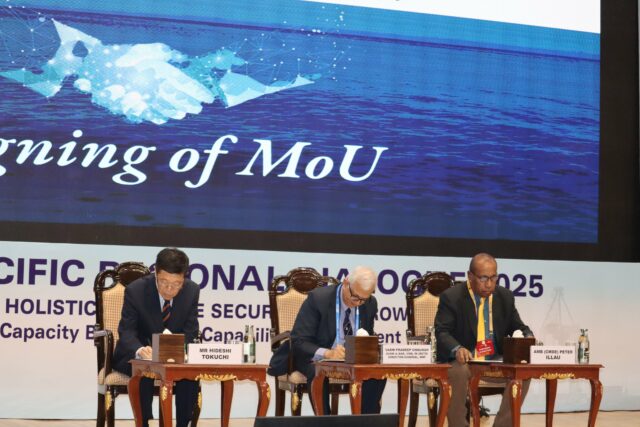Imagine a Pacific-India Digital Corridor linked through shared digital infrastructure. Data connectivity cyber-standards, and digital inclusion could become new pillars of Indo-Pacific cooperation — parallel to maritime security and trade.
“We envision a Pacific-India Digital Corridor, a strategic pathway that links data, sovereignty and shared prosperity,” said Peter Ilau, former head of the PNG Defence Force, who was addressing the Indo-Pacific Regional Dialogue in Delhi.
“This corridor would not only connect our fibre and subsea assets but also harmonise cybersecurity standards, digital-trade protocols and regional innovation ecosystems.”
Ilau added that the corridor would allow students, entrepreneurs, and institutions across the Indo-Pacific to collaborate safely and securely.
“From mud hut to UPI, India has shown the world that digital transformation can be both sovereign and scalable,” he said. “We seek to learn, adapt and co-create, not replicate.”
Reimagining PNG
For decades, Papua New Guinea has been viewed largely through the lens of mineral and energy resources. Ilau’s remarks signal a re-imagination of the country’s role, from a commodities exporter to a digital pivot in the Pacific.
“Connectivity is sovereignty,” he declared. “The ability to transmit data securely, communicate without constraint and access digital infrastructure is the foundation of national resilience and regional agency.”
That vision aligns with PNG’s recent infrastructure moves. In November 2024, the country joined Google’s Pacific Connect Initiative, participating in the construction of the Bulikula subsea cable branch to Manus Island.
Once operational, the cable will strengthen regional data routes between Guam, Fiji and other Pacific nodes — positioning PNG as a potential data-landing and transit hub.
The digital push also builds on PNG’s MoU with India signed in July 2023 to explore the adoption of India Stack, the suite of open-source digital public goods behind India’s success in digital identity, payments, and e-governance.
Through these steps, Port Moresby is signalling that digital infrastructure is not just an economic tool, it is strategic sovereignty infrastructure, central to both security and development.
Strategic Convergence
For India, the Pacific-India Digital Corridor dovetails neatly with its own strategic priorities. Under the Indo-Pacific Oceans Initiative (IPOI) and Act East Policy, New Delhi has sought to deepen digital and maritime linkages with partners beyond its immediate neighbourhood.
India’s global leadership in digital public infrastructure — from Aadhaar and UPI to DigiLocker and India Stack — gives it unique leverage as a technology partner that offers interoperable, inclusive, and sovereign alternatives to Western or Chinese digital ecosystems.
By aligning with India, PNG and other Pacific states can gain not only connectivity but also a model of digital governance rooted in open standards, consent-based data sharing, and public-private innovation. The arrangement would also strengthen India’s soft-power footprint across the wider Indo-Pacific, allowing it to engage with the Pacific Islands in a development-oriented, non-hegemonic manner.
If realised, the Pacific-India Digital Corridor could yield tangible regional benefits:
High-speed Subsea Connectivity: Linking Pacific cable networks like Bulikula to Indian landing stations would reduce latency and build redundancy across the Indo-Pacific data grid.
Shared Cybersecurity and Data Standards: Harmonising frameworks could enable secure cross-border collaboration in finance, education, research, and e-commerce.
Innovation Partnerships: Joint research hubs and student exchange programmes could tackle regional challenges such as ocean health, climate adaptation, and disaster-management tech.
Inclusive Growth: Improved access to broadband and digital finance could empower island communities, boosting local enterprise and reducing digital inequality.
Such collaboration could also complement India’s broader outreach to the Global South, enhancing its credibility as a partner that exports not just hardware, but institutional know-how and governance models.
Yet, translating this digital corridor from concept to reality will demand sustained political will and investment. Subsea cable projects are capital-intensive, and maintaining them across dispersed island geographies requires long-term partnerships.
Within PNG itself, digital divides remain stark: only 15–20 per cent of the population has consistent internet access. Local last-mile networks, stable power supply, and human-capital development must keep pace if the benefits are to be broadly felt.
Equally, expanding digital infrastructure heightens exposure to cyber-risks and data-sovereignty concerns, issues that require robust governance and coordinated regional frameworks.
Still, for both PNG and India, the political and symbolic value of this proposal is immense. It demonstrates how digital technology, once viewed as an adjunct to development, has become a core axis of strategic autonomy in the Indo-Pacific.
A future Pacific-India Digital Corridor could mirror India’s “Digital Public Goods” diplomacy: interoperable, inclusive, and affordable. If supported by regional stakeholders, such as Fiji, Tonga, and the Solomon Islands, and multilateral partners, it could transform the Pacific’s digital map.
For India, the corridor offers a route to extend its influence beyond the Indian Ocean without stepping into the traditional military competition that defines the US–China rivalry in the Pacific. For Papua New Guinea, it promises to convert its geography into digital geoeconomic leverage.





